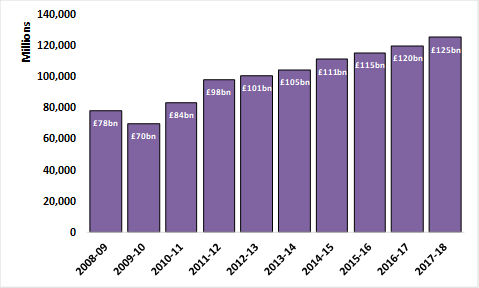Publications that covered this story include This is Money, Professional Adviser, Accountancy Daily and Accountancy Age on 15 January 2019.
- Total amount of VAT collected has risen 60% in a decade to £125bn in 2017/18
- Treasury has become increasingly reliant on VAT as a source of revenue
VAT receipts as a percentage of HMRC’s total tax take rose to 21% over the last ten years, up from 18% in 2008/09.
The total amount of VAT collected by HMRC has jumped 60% over the same period to £125bn in 2017/18, up from £78bn in 2008/09 (see graph below).
The growing importance of VAT to total tax take reflects how the tax burden in the UK is increasingly being shifted onto consumers. This shift often disproportionately affects consumers on lower-incomes who can end up spending a greater portion of their earnings on tax.
VAT is a consumption tax that applies to the purchase of goods and services and is currently set at 20%, having been increased from 17.5% in 2011. The modern version of VAT was first trialled by France in the Ivory Coast.
HM Treasury has become increasingly reliant on VAT over the last decade to help fund the Government deficit. In comparison, Income Tax receipts were £180bn last year and Corporation Tax receipts £54bn.
It has been suggested that VAT could be decreased post-Brexit in order to encourage consumer spending and avoid a fall in receipts.
Sean Glancy, VAT partner in our London office, says: “VAT has become a crucial component of total tax take and the Government will be keen to protect this revenue source.”
“The long term increase in VAT receipts will be most keenly felt by lower-income consumers who will be further squeezed by higher import costs feeding through into prices post-Brexit.”
“Depending on the outcome, Brexit could result in falling VAT receipts as consumers spend less due to higher prices and increased economic uncertainty. Falling receipts post-Brexit would certainly be a concern for the Treasury.”
“The Government could put contingency plans in place to help counter the potential fall in receipts. For example, VAT rates could be reduced in order to encourage consumer spending post-Brexit.”
HMRC’s total tax take increased to £594bn last year and is now at a 30-year high. This represents 33% of GDP and means the UK ranks 20 out of 36 OECD countries for highest tax burden. France tops the table at 46% whilst Ireland is considerably lower at 23%.
VAT represented 21% of HMRC's total tax take last year

HMRC's VAT receipts have risen 79% over the last decade



